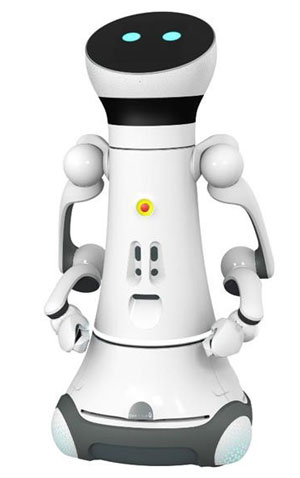Human-robot interaction unlocks potential of service robotics
Together graphics displays, artificial intelligence and sensors, enable advances in human-robot interaction and are ushering in a new generation of service robots that are easy to programme and intuitive to use. In Munich, from 19-22nd June, 2018, automatica will demonstrate how products and systems - from flexible, collaborative robot tools to smart warehouses and humanoids - place people at the heart of their design, enabling not only better assistance and collaboration but also reduced costs.
“We don’t have a magic solution, but we’ve improved a lot,” said Francesco Ferro, CEO of PAL Robotics, the Barcelona-based pioneer of humanoid robots. “When we made our first biped robot in 2004, we needed at least five engineers to use it. Now, a client can turn it on and control it themselves. In the future, we will only have to speak with the robot and it will complete a task.”
The robots are already used for entertainment and in healthcare. The company is 18 months into a retail pilot with a robot that autonomously navigates aisles full of shoppers to provide an exhaustive, daily, 3D inventory. It’s something few retailers can currently achieve, but this kind of data is invaluable for optimised decision making, explains Ferro.
Retailers are also taking advantage of highly adaptable mobile robots to provide in-store guidance and information for customers. Equipped with a dazzling array of features, including multi-modal controls with reassuring feedback in the form of expressions, lights and sounds, the Care-o-Bot 4, is now marketed by Unity Robotics, a Fraunhofer IPA spin-off. The robot’s award-winning design can already be seen hard at work at the German electronics store, Saturn Ingolstadt, helping customers find products and summoning staff when human assistance is needed.
A core technology for industrial and service robotics
The European Commission’s Horizon 2020 (H2020) work programme identifies human-robot interaction (HRI) as one of four core robotics technologies, to which it is pledging project funding of €66m for 2018-20. “Human-machine interaction or HRI is considered key for both industrial and service robotics,” says Martin Haegele, Head of Robot and Assistive Systems at Fraunhofer IPA. “The robot is a part of a scenario operated by professional end-users and service companies, in agriculture, healthcare and rehabilitation, logistics, security and retail. Most of these applications share one common feature, they operate without a safety fence. Exposed to everyday environments, robots have to meet safety standards, they have to be operated safely and intuitively, so obviously HRI is the most important feature.”
 For logistics, increasingly safe and effective interaction between robots and humans holds the promise of highly-flexible warehouses, the focus of H2020 funded project, SafeLog. With sensors embedded in their mandatory safety vests, human workers can be easily located by the system, while augmented reality assists them in a variety of roles, providing picking, navigating and maintenance information.
For logistics, increasingly safe and effective interaction between robots and humans holds the promise of highly-flexible warehouses, the focus of H2020 funded project, SafeLog. With sensors embedded in their mandatory safety vests, human workers can be easily located by the system, while augmented reality assists them in a variety of roles, providing picking, navigating and maintenance information.
Improving capabilities for robots, empowering businesses
The drivers behind safe, dependable human-robot interaction are artificial intelligence, machine learning models and sensors, such as the illuminating artificial skin, developed by TUM's Institute for Cognitive Systems to react to proximity. Europe leads innovation to embody intelligence into mechanical robots. The objective is to make machines that are sensitive enough to not only avoid potentially harmful contact, but so they can even be guided with a feather.
“An area that I find really exciting is how to simplify teaching tasks to robots,” said Samuel Bouchard, CEO of Robotiq, Canadian manufacturers of collaborative robot tools. “Right now, we’re still using very low-level instructions. It requires a lot of expertise. If robots can have a higher level of abstraction, it’s going to be much easier to collaborate. The challenge is to put more intelligence into the different components.” The company’s goal is to empower businesses by showing them how to install robots by themselves, thus helping them to overcome workforce challenges, including a shrinking labour pool. “Obviously, the real goal is that we need to collaborate seamlessly,” said Bouchard.
The service robotics area at automatica 2018 boasts an unparalleled array of HRI technologies, being developed to provide safe, economical, flexible automation solutions; to safeguard the jobs of older employees and to allow controls and even emotional quality of experience to be tailored to the user, and leading to one of the most significant technical step changes in robotics.










